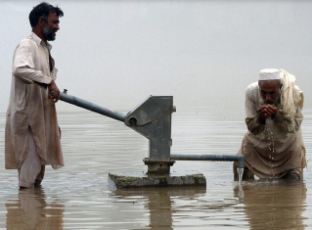PESHAWAR, Apr 06 (APP/DNA):Water scarcity has emerged as a major issue in Pakistan, exacerbated by factors such as climate change, rapid population growth, deforestation and inefficient water management.
Once endowed with abundant water resources, the country is facing a growing water crisis due to the non-construction of dams, and waste of irrigation water that threatens food security and the livelihoods of people.
Agriculture is the backbone of Pakistan’s economy, and the ongoing water shortage worsened by insufficient snowfall and rainfall, has far-reaching consequences for food production.
As the population continues to increase, the experts said the challenge of ensuring adequate water for agricultural needs becomes even more daunting.
“Pakistan is home to one of the largest irrigation systems in the world, drawing heavily from the Indus River and its tributaries. However, the available water per capita has drastically decreased over the past few decades,” explained Sumbal Riaz, an economist, in an interview with APP on Sunday.
She highlighted the snowless winter in Khyber Pakhtunkhwa, which has intensified the water scarcity problem, leading to lower water levels in reservoirs.
According to the Pakistan Council of Research in Water Resources (PCRWR), the country’s per capita water availability has plummeted from 5,000 cubic meters in 1951 to less than 1,000 cubic meters today. This sharp decline has pushed Pakistan into a state of water scarcity, compounded further by population growth, urbanization, and inefficient water usage.
Sumbal Riaz said that one of the primary causes of water scarcity is the over-extraction of water from the Indus River system and car washing machines.
Approximately 90% of the country’s available water is used for agriculture, with a significant portion wasted due to outdated irrigation techniques.
Furthermore, the construction of large dams and canals in neighbouring countries has negatively impacted on the natural flow of water, reducing Pakistan’s access to these critical resources.
The southern districts of Khyber Pakhtunkhwa, Punjab, and the Cholistan Desert in Sindh hold great potential to meet the nation’s food requirements, provided that irrigation water is made available.
Riaz welcomed the Green Pakistan Initiative launched in Cholistan in February by the Chief Minister of Punjab, which aims to transform agriculture in the region by providing local farmers with high-quality seeds, fertilizers, pesticides, and affordable agricultural machinery, including drones.
A 5,000-acre state-of-the-art agricultural farm will serve as a model for modern farming techniques, focusing on water-efficient practices and advanced irrigation systems to reduce costs and increase agricultural yields.
Gulzar Rehman, a former Conservator of Forests, emphasized that Pakistan is highly vulnerable to the impacts of climate change, including erratic rainfall patterns, extended droughts, and the rapid melting of glaciers in the Himalayas. These shifts disrupt water availability and complicate agricultural production.
Gulzar noted that Pakistan’s agriculture relies heavily on irrigation, with major crops like wheat, rice, cotton, and sugarcane requiring substantial water.
“Water scarcity has resulted in lower crop yields, particularly in arid and semi-arid regions. This shortage also affects livestock farming and the fisheries sector, reducing food availability and variety.”
The water crisis, Gulzar argued, requires a multifaceted approach, including both short-term and long-term strategies for improving water management and safeguarding food security.
These strategies should encompass overhauling outdated irrigation systems, constructing new dams, implementing better water conservation practices, desalination, and water recycling, while also adapting to climate change and investing in infrastructure.
Ibrahim Khan, Deputy Project Director of the 10 Billion Trees Afforestation Project, highlighted the progress of the Green Growth Initiative (GGI), which began in 2014. Since then, Rs. 675 billion has been invested in protecting and promoting forest resources, resulting in 26.7% of the province’s land being covered by forests, exceeding international standards.
He noted that the province’s forests harbour vast mineral reserves and agricultural potential, which could generate Rs. 215 billion annually if commercialized.
Additionally, carbon credits from these forests are valued at around Rs. 100 billion annually. The project has created more than 175,000 green jobs, contributing to land cultivation and improved water resource management.
Ongoing initiatives, such as the plantation around the Chashma Right Bank Canal (CRBC) project, which aims to cultivate 300,000 acres of barren land, and the Rs. 5 billion Mohmand Dam Canal project, set to irrigate over 200,000 acres, are vital to addressing Pakistan’s water needs.
Experts remained hopeful that the swift completion of major dams like the Mohmand, Diamer-Bhasha, and Dasu dams will significantly alleviate Pakistan’s water problems, ensuring food security and protecting the livelihoods of millions who largely depend on agriculture for their survival.

















